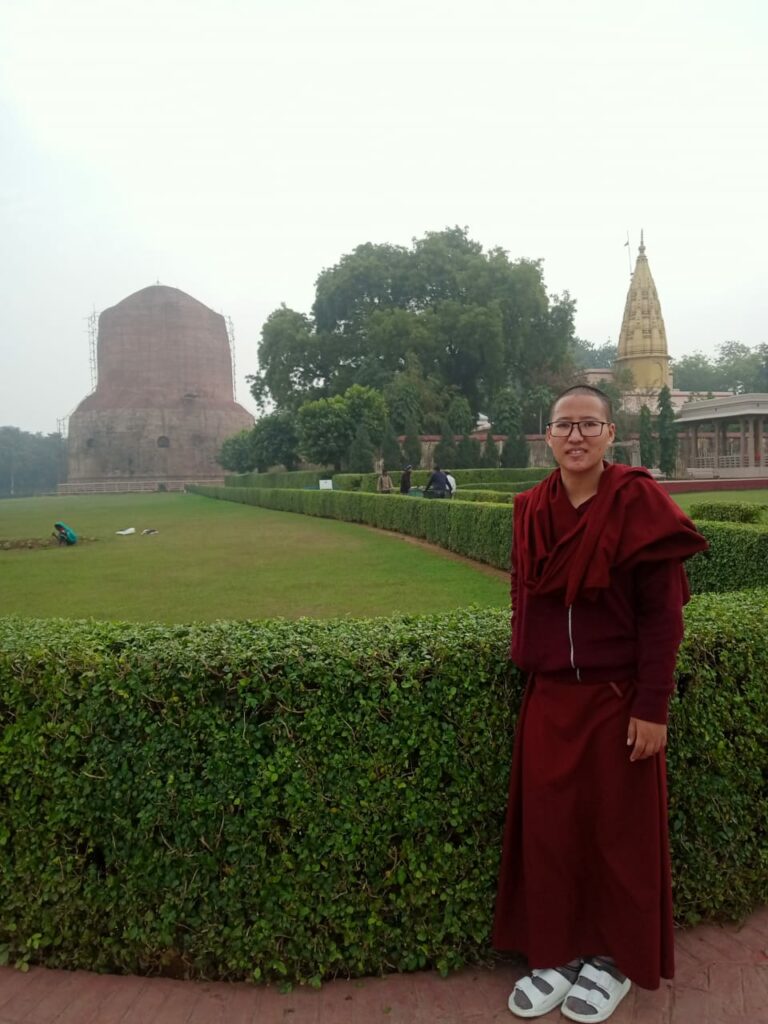India is currently home to over 150,000 Tibetan refugees in exile. This community has become incredibly self-sufficient and is one of the most prosperous refugee communities globally. Spread across 12 Indian states, there are 40 Tibetan settlements in Himachal Pradesh, Uttarakhand, Delhi, Uttar Pradesh, Ladakh, Sikkim, Arunachal Pradesh, West Bengal, Chhattisgarh, Odisha, Maharashtra, Meghalaya, and Karnataka.
Sarnath, located in Varanasi City of Uttar Pradesh, is referred to as mini Tibet by the locals. The residents, often dressed in traditional red attire, create a peaceful atmosphere with monks, nuns, and commoners going about their daily routines. Their simplicity and harmony are evident in their way of life.
To sustain Lord Buddha’s teachings to the present day Buddhism sustained an order of monks and nuns as a monastic community(s). These communities practice, preserve, and share the Buddha’s teachings on the three higher training—ethical conduct, concentration, and wisdom.
The admission of women monks and the establishment of continuous lineage for full ordination since its inception of the movement was accompanied by controversy. Many Buddhist nuns now hold leadership roles, requiring ordination or academic degrees. This is a departure from past monastic traditions.
Many Buddhist women and feminist scholars backed this vision, emphasising education and leadership roles amongst the nuns.

Overcoming the dwindling situation of Bhikkhunī or the Buddhist nuns in Ladakh and those of the community there, Tsering Lhadon a female novice or a śrāmaṇerī catering to the far-sighted vision of her teacher aims to serve back her community after she graduates with a Master’s of Philosophy. 25-year-old, came to Varanasi to CIHTS or Central Institute of Higher Tibetan Studies 8 years ago, leaving her family behind.
CIHTS is the first central university providing all-round education to the Tibetan diaspora in India, the institute is considered to be the premier Tibetan-based institution of higher education and is a centre of research in Tibetology, working on the restoration of historical texts, and imparting knowledge of the four Sampradayas (schools) of Buddhism.
Amid the serene tranquillity of Sarnath away from all the hustle- and bustle of Varanasi City; at the Central Institute of Higher Tibetan Studies what progresses is the tale of these young nuns, who wish to transpose the age-old tradition that befalls them unknowingly.
‘It is an archaic tradition to give away the middle child of the family to the monastery, as service to the community, because more and more people choose to have fewer children therefore very few of them from the community choose to serve as a monk or nun,’ Tsering Lhadon tells FII.
It was very early that she was christened as a nun, being the third child among her five siblings in the family. Her parents ought to submit her to the nunnery The Ladakh Nuns Association- LNA.
‘This is how it is, this is what every underprivileged family do, it is because of impoverished financial situation that the giving away tradition flourished, it also caters for the need for new monks and nuns at the monastery and nunnery,’ she adds.
Although she feels proud to be a part of the LNA Ladakh, ‘I feel fortunate enough to have met and have received the guidance of Dr. Tsering Palmo at the Ladakh Nun Association, I owe everything to her,’ says Lhadon.
Venerable Dr. Tsering Palmo is a Ladakhi nun and an AMCHI- a traditional Tibetan Medical doctor, it was in 1996 that she laid down the foundation of the Ladakh Nuns Association and went on to become the first female head of a nunnery in Ladakh.

Dr. Tsering Palmo had a formal education like any other privileged woman. She completed her higher education at the Central Institute of Higher Tibetan Studies, and later in her life after her father’s demise she chose to be a nun and followed the path she was meant for.
‘She served her inner willingness, with an aim to provide opportunities to young girls, whose family might have experienced difficulties providing them education and good life,’ exclaims Lhadon.
On account of providing secular and monastic education to the girls at the nunnery, Dr. Palmo faced backlash and criticism from the community. The population disagreed with the idea of an all-women nunnery, led by women, which is not the usual tradition says Lhadon. She went on to add how the community typecasts them as just a spiritual beings whose mere job is to do routine Puja at houses, at funerals, etc.
Those women are not allowed to live in the monastery with the monks, therefore they take shelter at their paternal homes or at their brother’s house, where they are treated as house helpers and have to manage all the household chores along with their routine work as nuns.
At CIHTS there are several other young women who resemble Lhadon. Adorned in a maroon robe, with gleaming eyes a radiant young woman that she is, Tsering Lhadon being the head of her wing is dutiful and enthusiastic, she was elected by several others alike when asked how does she adhere to her responsibility, honest enough to answer, she says that she never has any obligations being the wing head, as the community and the environment at the campus is supportive and peaceful, they could walk around freely even late at nights without feeling insecure.

Lhadon is one of the first two girls from a nunnery who studied outside the traditional nun school at a co-ed, her education is largely funded by various donations and sponsorships that the Nuns Association receives, thanks to the efforts of Dr. Tsring Palmo. It is her vision to provide secular and monastic education to all the nuns and give them the opportunity to obtain higher education in Buddhist Philosophy and Traditional Tibetan Medical Studies ‘Sowa-Rigpa,’ outside Ladakh that favourably all the younger nuns now are into higher education distinct from the traditional eclipse.
While her teachers and family want her to become a research scholar with a Phd, she holds a determination to serve her community. While the life of a nun is full of challenges and hurdles Dr. Palmo paved and polished smooth into opportunities not only for them but also the whole community.
Lhadon wishes to go the extra mile to this and help with the upcoming projects at the nunnery and shape the future of the young nuns.
Driven by the desire to explore, be independent on her purpose and chart her own path, during their 40 days vacation, back home she chooses to be at the nunnery for the first 3 weeks and serve like others in teaching the youngsters and doing several other odd jobs in the office.

Later on, if she wishes, she can spare some time to visit home with her parents, before returning back to the university.
Walking around the campus one might see several nuns and Tibetan women like Tsering Lhadon, coalesced into a plain sailing community, with great zeal and self-esteem having high regard and determined belief in education with their adorning smile, witnessing their diaspora evolve to a better future.
About the author(s)
Anupama intends to be an artist in neutral, aka a dabbler- cum-learner. Her interests lie in music, nature, stories transcending cultural boundaries, human welfare, etc. When she is not around she can be found strolling along the ghats of Varanasi. To add she has a lab- named Miley.






